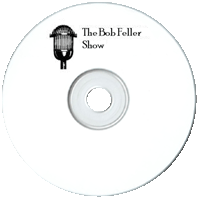

Signed with the Cleveland Indians at the age of 17, Bob Feller served during WWII and returned to the states to become one of the greatest baseball players in the history of the game.

18 old time radio show recordings
(total playtime 3 hours, 22 min)
available in the following formats:
1 MP3 CD
or
4 Audio CDs
Text on OTRCAT.com ©2001-2025 OTRCAT INC All Rights Reserved. Reproduction is prohibited.

When we talk about sports heroes, we usually mean players who have given a super-human effort to insure their own victory, or that of their team. There can be no argument that Bob Feller did that during his glorious 20 year career with the Cleveland Indian, but Bob's efforts helped to improve the game itself, especially conditions for players of color.

Feller was born in 1918 and grew up on his father's farm in Van Meter, Iowa. Recognizing the boy's talents early the senior Feller converted his acreage from raising corn to less labor intensive wheat so that he could dedicate more time to coaching the boy. They even built a diamond (complete with scoreboard and concessions area) which attracted high school and semi-pro teams. By the age of sixteen, Bob began to attract the attention of the scouts, but it was too late; he had already signed with the Indians.
Bob playing in Cleveland was a dream for his father. What no one expected was for the 17 year old phenom to go directly to the big leagues without spending time in the farm-club system. How many players can say they struck out 15 players in their major league debut, finish their rookie season with a 5-3 record, and then return home for their senior year of high school?
Feller was on his way to sign a new contract with the Indians when he heard the news about the Pearl Harbor attack. Two days later, he became the first professional athlete to enlist. He became a gun captain on the USS Alabama, serving in both the Atlantic and Pacific campaigns. To keep his arm in shape, he took time to throw on the deck outside his turret.
While many vets worried whether they would have a job after the war, there was no question that the Indians were very happy to have Bob back after four years service. His discharge came late in the 1945 season. When he returned home on August 24, he was greeted by a civic luncheon, a parade, and then was tapped to start against the Detroit Lions. Bob related the experience in The Bob Feller Show #23.
During the off-season, Feller maintained a busy schedule of barnstorming exhibition games, often showcasing Negro League players on his exhibition teams. In 1947, he announced that he would play in the Cuban Winter League in defiance of "grossly unfair" league rules. Latin players were allowed to play in the Winter Leagues but there was no such work available for American players. Feller claimed he was trying to make up the earnings he lost during his War service, and that he needed the money for his family's medical expenses. His efforts are credited with bringing greater recognition to the talent of Negro League players.
On September 9, 1956, the Indians held "Bob Feller Night" and Bob appeared in his last professional game. Although the Indians made it known that he would always have a job with the organization, he choose to sell insurance. In 1966, Bob recorded The Bob Feller Show.
The Bob Feller Show was a series of short spots which were sold into syndication. Each of the recordings in this collection feature the transcription disk recordings, each with several of the 3-4 minute spots. Bob introduces the great event he will be describing, then breaks for a sixty second commercial message. After concluding the sports drama, there is another break for the local station to insert more commercials.
Along with Bob's own return to baseball, the sport's memories featured on the Bob Feller Show include the 1956 Indianapolis 500, Lou Gehrig's attempt at five homers in a single game, the 1936 Stanley Cup game which went into multiple over-times until 2 in the morning, Wilt Chamberlain scoring 100 points in a single game, and many others.
Text on OTRCAT.com ©2001-2025 OTRCAT INC All Rights Reserved. Reproduction is prohibited.
You have reached the maximum number of votes for a unregistered user.
Please login or create a new account to continue...
You have reached the maximum number to down votes in this page.



Bob Feller Show Disc A001
|
Add Audio CD to Cart - $5.00 |
Bob Feller Show Disc A002
|
Add Audio CD to Cart - $5.00 |
Bob Feller Show Disc A003
|
Add Audio CD to Cart - $5.00 |
Bob Feller Show Disc A004
|
Add Audio CD to Cart - $5.00 |
Please wait...
COMMENTS
Be the first to comment on "Bob Feller Show"
Leave a comment